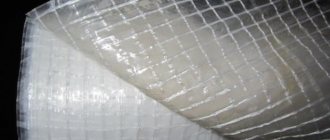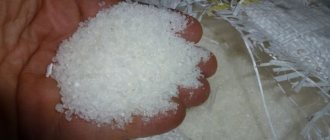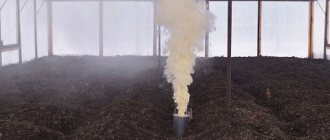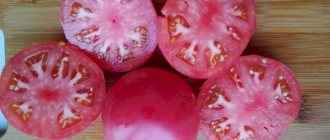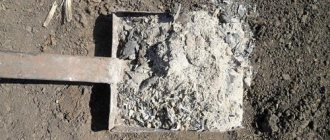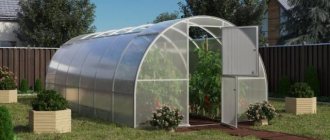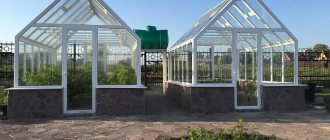The warming climate in many regions means that gardeners simply do not know at what temperature they should cover grapes for the winter, and what to do if the desired weather does not arrive. We will find the answer and tell you what type of shelter for grapes is preferable and when is the best time to carry out this procedure.
Of course, no one will give an exact calendar answer to the question of when to cover grapes for the winter. It depends on the region, the weather, and the age of your vine. But there are still certain signs that the period for this work has arrived and it cannot be postponed any longer.
When should grapes be covered?
Grape roots can freeze at temperatures below -5 °C, so all work is carried out before this point. If the root system freezes, the entire bush will die. When the above-ground part freezes, the grapes can be restored.
There are varieties that can withstand frost down to -28 °C, but even they can freeze at a temperature of -20 °C. If the temperature is predicted to drop to at least -4...-5 °C, frost-resistant grapes need to be insulated.
Why is it important to strictly observe the timing of covering grapes for the winter:
- if insulation is done too early, there is a risk of the plant rotting, becoming moldy, creating condensation, which causes the crop to die;
- if you are late with insulation, the roots will freeze.
Measures to cover the bush are carried out only in dry weather - there should be no traces of high humidity on the soil and plant.
The main condition is that the vine is hardened, i.e., it is given the opportunity to endure the first frosts while open. This rule applies exclusively to adult crops.
Why should the vine be protected from frost?
The vine may not be ripe in the fall, and encountering frost will be disastrous for it. In addition, the first frosts can be quite severe, and they can kill the buds of even mature vines.
Electrical tape marks the border between ripened and unripe vines; this will allow you to see which part of the vine will ripen under cover in winter.
Victor Tatievsky
Much depends on the frost resistance of the variety, but the bush gains frost resistance gradually. If the frost resistance of a bush is -30 degrees or more, then in September it is -5 - -6 degrees, in October -7 and below, and so on. Therefore, frosts in the first ten days of October are especially dangerous. And if the variety is not winter-hardy, frost resistance indicators are lower, then the first frost can kill the vine.
Winegrowers usually make shelter for all the bushes at once, without dividing them into frost-resistant and non-frost-resistant. Therefore, it is better to play it safe and cover everything early.
A vine that has not been hit by frost is always preserved better during wintering.
Choosing timing based on geographic location
The time of warming depends on the regional growth of the crop:
- Moscow region and Leningrad region. The average daily air temperature should be no more than -2 °C, so the work process is carried out after November 20 and before December 10. Preparations should begin in late September.
- Ural and Western Siberia. Preparatory activities are carried out from late August to early September. Shelter period is from October to early November.
- Central Russia. The vine takes shelter 20-30 days after the leaves completely fall off, i.e. in mid-November.
- Ukraine. These are relatively warm regions, where the timing of grape warming shifts towards winter, especially with the late onset of “Indian summer”. The optimal period is November, in the south of Ukraine – December.
What mistakes should not be made?
Novice winegrowers, when preparing vines for winter, may, due to inexperience, make the following mistakes:
- pour too thick a layer of earth over the shelter;
- do not hill up the lower part of the trunk before covering the grapes;
- lay an insufficiently thick layer of mulch under the vine;
- choose the wrong covering method for a particular grape variety;
- it is too late to build a shelter;
- do not carry out preparatory measures before installing the shelter - pruning, fungicide treatment, fertilizing;
- When hilling, rake the soil too close to the trunk, exposing the root system.
Detailed article about caring for grapes in autumn
All these mistakes can lead to such sad consequences as the development of infections, death of eyes and roots, which invariably entails a decrease in yield. Young seedlings may die. To prevent this from happening, carefully study the information provided in the article and reinforce it while watching the following video:
Preparing grapes for shelter
An important factor is the preparatory measures before covering the grapes for the winter. In the North, there is no natural leaf fall before the first frost, so gardeners artificially remove leaves from the grape bush and remove weeds from the tree trunk.
Processing times
Pruning and other measures to prepare grapes for wintering are carried out after the leaves have fallen. It is important that the night temperature is constant between 0 and -2 °C.
Feeding
Fertilizers are applied 2-3 weeks before moisture recharging. In order for the grapes to overwinter normally and produce a rich harvest in the spring, you need to add nutrients, but it is forbidden to feed them with nitrogen in the fall.
For autumn feeding of grape bushes, you can use the following composition:
- For 10 liters of water, take up to 15 g of potassium and 20 g of phosphorus.
- Add about 12-15 drops of pharmaceutical iodine to the solution.
- Add powdered boric acid (5 g) to the mixture.
The indicated dosage is designed for watering one bush.
Treatment against diseases
To avoid the spread of pests, the bush and the surrounding area are sprayed with copper sulfate (100 g of substance per 9-10 liters of water). The following compounds are used against diseases:
- From fungal and infectious diseases. For 9-10 liters of water, take 35-40 g of table salt, 15-20 g of soda, 7-10 drops of iodine.
- Against mildew and oidium. A pink solution of manganese or colloidal sulfur is used (10 g of powder per 9-10 liters of water).
If you do not want to use such products, buy ready-made drugs - Topaz, Ridomil or Fundazol. Strictly follow the instructions for use, which are detailed on the products.
Other events
What else needs to be done when preparing a grape bush for shelter:
- 3 days before insulation, carry out moisture recharging, since completely dry soil freezes more strongly. To do this, dig several holes as drainage holes. Water the plant with 20 liters of water for 1 year of life.
- Allow the branches to mature until they turn brown. To do this, remove the shoots from the trellises and spread them on the ground. This will allow light to reach all branches.
- Trim the bushes - remove diseased and damaged elements, thin shoots and tops (thick branches growing vertically from the old sleeve). From the young growth, leave up to 8 shoots, which have managed to become woody and grow 4 buds. Shorten last year's shoots so that there are up to 12-15 eyes left.
- Make a catarrh - remove the dew roots located at a depth of up to 25 cm (they will freeze). To do this, dig a hole around the trunk, select horizontal root shoots, and cut them off at the base of the root. Disinfect the cut areas with a weak solution of potassium permanganate.
What needs to be done to prevent grapes from spoiling
To prevent the bush from starting to rot under cover, use only “breathable” materials. This means that the use of film is unacceptable.
Try not to cover the plant after rain. Damp shoots will definitely begin to rot.
Also pick off all the berries and treat with fungicides. This will prevent the fungus from spreading.
And, most importantly, take your time with cover. If you insulate the plant ahead of time, condensation will inevitably begin to accumulate, which will lead to damping off.
What are the ways to cover grapes for the winter?
There are many methods for insulating grapes, but there is a basic rule - the root system is covered to a greater extent. It is the roots that are most often exposed to freezing.
Hilling
This is the fastest and most cost-effective method. The main condition is loose soil and light moisture. For heat capacity, sawdust can be added.
How to properly earth up grapes before wintering - step-by-step instructions:
- Clear a 1 m area around the bush.
- Use a garden tool to build a mound 13-15 cm high around the trunk.
- Treat the area with a weak solution of manganese.
- Place herbs that repel mice.
When snow appears, throw it on the hill. If grapes grow in northern latitudes, the height of the hill is at least 25 cm, the radius is 30-40 cm.
An experienced gardener will tell you about hilling grapes in the following video:
Partial cover
This method is suitable for regions with warm winters. It involves the use of soil and available materials - straw, fabric, burlap, film, agrofibre, hay, etc.
The process of partial insulation of grapes:
- Cover the lower part of the bush with a layer of soil (as when hilling).
- Tie the plant branches into one bundle using twine.
- Place covering material or straw on the ground.
- Place the grapes, press them with boards or car tires.
- Cover, for example, with film.
The thickness of the covering material should not exceed 5 cm.
Full Cover
It is rational to use such insulation in severe frosts. Step-by-step instructions for complete cover:
- Remove the branches from the trellises, collect them in one bunch, tying them with a rope.
- Dig a shallow ditch to accommodate half the height of the tied vines. Pour sawdust (straw, hay, etc.) into it.
- Wrap the branches with geotextile material.
- Press the branches into the ditch using gentle movements to avoid breaking the vines.
- Cover with soil.
- After snow falls, sprinkle the structure with it.
Straw or reed
An eco-friendly and breathable way to insulate grapes for the winter. The first thing to do is to prepare reed, cattail or straw from grain crops. The material is first thoroughly dried under the sun.
How to insulate a grape bush with straw or reeds:
- Gather the grape vines into a bunch.
- Place straw on the ground and press the grapes on top.
- Sprinkle with straw in a layer of at least 20 cm.
- After a couple of weeks, add the same amount of covering material.
- Secure the structure with ropes, plastic clamps, or cover with netting to prevent the straw from flying away during winds.
You can also learn about sheltering grapes in the following video:
Use of snow
The method is effective in Siberia and regions where there is a lot of winter precipitation for a long time. An important factor is that the grapes must be resistant to temperatures down to -10 °C.
The process of creating a snow shelter:
- Tie the vines into a bundle.
- Place pieces of plywood or boards on the surface of the ground.
- Place the grapes on them and secure them with wire/staples.
- Cover with snow. The layer should be at least 40-50 cm.
- Press down gently.
Throughout the winter, add snow and be sure to compact it. The higher the layer, the warmer the plant.
Slate cover
Slate is used as a material at hand (in its absence, it is replaced with boards, roofing felt, etc.). How to make a trench shelter:
- Dig a trench along the length of the branches that will fit into it. Depth – up to 30 cm.
- In very harsh climatic conditions, insulate the ditch with boards along the sides and bottom.
- Tie the vine with twine, wrap it with burlap (agrofibre, etc.).
- Place the grapes in the trench, cover the top with slate so that it protrudes 15 cm from the sides.
- Sprinkle with soil to fix the structure.
Using spunbond
Spunbond is the technical name for a series of covers. For example, agrofibre, airlade, fiberglass, etc. The material is opaque and differs in moisture conductivity only on one side. It is considered breathable, so the plant under it breathes.
Proper air ventilation keeps the grapes dry and warm at the same time. Consequently, there is no condensation, which prevents the branches from rotting.
Spunbond is used in all climatic conditions. Gardeners recommend combining the material with natural raw materials - straw, hay. You can cover grapes with this material directly on trellises, bent to the ground:
- Tie the branches and bend them to the ground, which is covered with leaves or straw.
- Secure with staples.
- Cover with spunbond.
- Strengthen the structure (sprinkle with earth).
For the Northern regions, it is recommended to use several layers of covering material.
Useful recommendations for covering grapes can be found in the video:
Shelter made of spruce branches
Among all the varieties of spruce branches, spruce is considered the best for insulating plants for the winter, but pine and fir can be used.
The scheme for covering grape bushes is very simple to implement:
- Place spruce branches on the soil.
- Place tied grapes on top.
- Cover with spruce branches to a height of 35-40 cm.
Using sawdust
The main condition is the dryness of the materials. The procedure includes the following steps:
- Cover the ground with plastic film.
- Place grape vines on top.
- Cover them generously with sawdust to a height of 30-40 cm.
- Lay slate, boards or other hard material on top to prevent moisture from passing through.
Covering with foliage
To insulate the grapes in winter, the foliage is collected during the season, thoroughly dried and stored in fabric bags. Leaves infected with pests or diseases should not be used.
Instructions:
- Dig a trench up to 18-22 cm deep.
- Place grape branches in it.
- Sprinkle with foliage to a height of 15 cm.
Cover the top with agrofibre, metal mesh or lay wooden boards. Otherwise, the foliage will be blown away by the wind.
Basic mistakes of newbies
Inexperienced actions by beginner gardeners can lead to mistakes and death of the grape bush during wintering. Here are the most common mistakes:
- When covering the grapevine with soil, some of the soil is taken from the root. This is not true, since the root system is more vulnerable to frost than the shoots. The soil should be taken from a free area, and not near the bush.
- When wrapping vines in a covering material, a loose wrap is often used. This leads to the fact that even minor gusts of wind will throw off the insulation and the buds on the shoots will freeze. Experienced gardeners near the bush recommend installing additional sides made of iron or wood for snow retention.
- The root system is often forgotten. The root must be insulated with peat, spruce branches or foliage.
- Beginners forget or neglect to prepare the plant before covering. Without fighting insects and bacteria, you can lose the plant.
- A strong insulating layer is laid between the ground and the vine. This is a big mistake because the soil warms the vine. The best option for lining is small pegs or planks.
- Shelter time. Covering it earlier will cause the plant to wither. Late covering may also cause harm to the grapes. The optimal time for covering a grape bush is the end of October, beginning of November.
Basic rules for insulating grapes
Regardless of the chosen method of covering grape bushes for the winter, adhere to the following rules:
- do not place grape branches on bare ground without available materials;
- if the ground part remains open and the area is blown by the wind, be sure to install protective barriers on the side of the air flow;
- try to cover the maximum area around the bush (at least a radius of 50-60 cm);
- mulch the areas between the rows;
- disinfect insulation;
- To repel rodents, additionally place other plants next to the grapes that do not like pests (tansy, black elderberry, wormwood, wild rosemary, calendula).
Use leaves, weeds, tomato tops, spruce branches, etc. as mulch between rows.
What to do before covering grapes
Before covering the grapes for the winter, be sure to remove the entire crop. Do not leave the grapes on the vine.
Next, be sure to trim the shoots. You won't need any more extra stems. At the same time, trim, adhering to a certain pattern.
After pruning, water the bush thoroughly. On average, an adult bush will need about 200 liters of water. Of course, if the autumn turns out to be rainy, then the volume of water can be reduced. But grapes cannot be left without moisture at all.
Be sure to treat the grape shoots, the soil under the bush, and the material with which you will cover the plant for the winter with fungicides.
The nuances of covering grapes depending on the region
The peculiarities of climatic conditions oblige us to adhere to the following rules for covering grapes:
- Moscow region. It is advisable to use the trench method of shelter. Material – dry (leaves, sawdust, spunbond). Film cannot be used.
- Leningrad region. Due to high humidity, the grapes are laid on the surface of the ground (without a trench). Due to stagnation of melt water in the spring, in the fall the vineyard is equipped with a drainage system. To insulate the bush, preference should be given to spruce branches and agrofibre.
- Kuban. Against the backdrop of a warm climate, Kuban grapes rarely require insulation - only those that grow in the lowlands. It is enough to use partial cover.
- Volga region. There is a sharp continental climate - with little snow, severe frosts in winter and hot summers. Therefore, the cover must be complete and powerful.
- Central Russia. The region is famous for its abundance of snow, so the best option is to insulate the grapes with snowdrifts and spruce branches.
- Chernozem region. Quite often on winter days the sun shines, warming the air to above-zero temperatures. Because of this, it is prohibited to use non-woven materials that do not allow air to pass through, otherwise condensation will occur. The best raw materials are agrofibre, spruce branches, foliage, etc.
Rules for covering grapes in other countries:
- Ukraine. In the southern part of Ukraine, grapes are not insulated. In other regions of the country, it is enough to make a shelter from foliage, spruce branches, spunbond, pressing the branches to the ground.
- Belarus. In countries with high humidity, trench structures are not used; grapes are laid on the ground or wrapped on trellises. The optimal material is spruce branches.
We recommend reading
- An original drink - rowan wine at home
- Popular and original recipes for peppers at home...
- Various recipes for the legendary Daiquiri cocktail
- Growing grapes in the Moscow region: specifics, choice...
- Watermelon moonshine: how to make it so as not to be disappointed...
- Moonshine from wine: nuances of distillation and popular recipes
- Tequila: how to drink correctly?
- Treatment of grapes with copper sulfate: benefits,…
- Moonshine from barley - soft taste of natural raw materials
Features of sheltering young grapes for the winter
Before insulating young trees, pruning is not carried out, but only the top is cut off to roughen the wood. This is the main difference in pre-winter activities from adult grapes. Watering stops in August.
Features of insulation of young grapes:
- Remove foliage if any remains.
- Dig a shallow ditch.
- Roll the vine into a ring.
- Secure the grapes in the trench.
- Cover with straw (you can use other material).
- Cover the top with boards or slate.
It is necessary to cover the plant before the first frost appears, since the vine of a young bush is still tender and is subject to freezing.
You can watch the video about sheltering young grapes:
Is it necessary to spray the vine with vitriol?
Before wintering, grapes are sprayed with iron or copper sulfate to destroy pests that may overwinter on the vine.
Iron sulfate also slows down the growing season: in the south, this technique allows you to avoid spring frosts, but in northern viticulture it has a negative effect.
Copper sulfate does not slow down the growing season, but it is not a fact that there is much benefit from it. There was a big discussion in the Russian grape community about the need for its use, and the participants came to the conclusion that such spraying was most likely not necessary.
Victor Tatievsky
Honestly, I have never sprayed grapes with copper and iron sulfate, neither in spring nor in autumn. But I don’t do anything unless really necessary, “just in case.” Everything is fine with me without spraying, my vineyard is always clean.
But let us repeat - our expert grows grapes in the Altai region, where the crop is infected with diseases and pests much less than in the south and even in Central Russia.
Answers to frequently asked questions
What is the best way to cover grapes for the winter?
The best option is a combination of natural ecological cover made of grass, sawdust, foliage and agrofibre.
When should the procedure be performed?
It's different in different regions. On average - after the first frost.
Do I need to add snow?
Necessarily. It is advisable to do this several times during the winter. Snow is a natural shelter for plants from frost.
What height should the shelter be?
Not less than 15 cm. The rest depends on the chosen method of carrying out the procedure.
Do I need to prune grapes for the winter?
Mature plants are pruned according to the selected pruning pattern. For young specimens, the tops of the shoots are lightly pruned for lignification.
Disinfection of covering material
All fabric materials used to cover the grapes must be thoroughly dried in the spring and special anti-fungal agents applied to them. After this, they are placed in a dry room or under a canopy. Check the material occasionally to prevent moisture from getting on it.
By the time you cover the grapes, you need to stock up on herbs such as wormwood, tansy, marigolds, and calendula to repel pests from the material. Bunches of these herbs are covered with dry leaves or straw. If there are rodents in the garden, you can set bait with poison or sprinkle with dust.
Covering with earth
The practice of burying grapes in soil came to us from the south, where there is no stable snow cover. It has its advantages - covering material is always at hand, but also a number of disadvantages - first of all, it is very labor-intensive, this is the first and second - bushes buried in the ground with frequent thaws in autumn and winter get very wet, and as a result, they get wet, the eyes rot and die. In some years the attacks can be very significant.
Before burying, it’s a good idea to place cut polypropylene fertilizer bags on the vines; this will greatly facilitate the work when digging up the vines, and will also preserve the aesthetic appearance.


